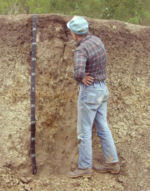Soil science
2007 Schools Wikipedia Selection. Related subjects: Geology and geophysics
Soil science deals with soil as a natural resource on the surface of the earth including soil formation, classification and mapping; physical, chemical, biological, and fertility properties of soils per se; and these properties in relation to the use and management of soils.
Sometimes terms which refer to branches of soil science, such as pedology (formation, chemistry, morphology and classification of soil) and edaphology (influence of soil on organisms, especially plants), are used as if synonymous with soil science. The diversity of names associated with this discipline is related to the various associations concerned. Indeed, engineers, agronomists, chemists, geologists, geographers, biologists, microbiologists, sylviculturists, sanitarians, archaeologists, and specialists in regional planning, all contribute to further knowledge of soils and the advancement of the soil sciences.
Because an understanding of soil science is important to the correct practice of a wide variety of disciplines, it is not unusual to find soils specialists within related disciplines. Soils specialists within related disciplines sometimes choose to refer to themselves as soils scientists, leading to some confusion as to qualifications. To distinguish themselves from soil specialists, professional soil scientists in the USA can seek professional registration and certification.
Soil Science Practice
Academically, soil scientists tend to be drawn to one of five areas of specialization: microbiology, pedology, edaphology, physics or chemistry. Yet the work specifics are very much dictated by the challenges facing our civilization's desire to sustain the land that supports it, and the distinctions between the sub-disciplines of soil science often blur in the process. Soil science professionals commonly stay current in soil chemistry, soil physics, soil microbiology, pedology, and applied soil science in related disciplines.
One interesting effort drawing in soil scientists in the USA as of 2004 is the Soil Quality Initiative. Central to the Soil Quality Initiative is developing indices of soil health and then monitoring them in a way that gives us long term (decade-to-decade) feedback on our performance as stewards of the planet. The effort includes understanding the functions of soil microbiotic crusts and exploring the potential to sequester atmospheric carbon in soil organic matter. The concept of soil quality, however, has not been without its share of controversy and criticism, including critiques by Nobel Laureate Norman Borlaug and World Food Prize Winner Pedro Sanchez.
A more traditional role for soil scientists has been to map soils. Most every area in the United States now has a published soil survey, which includes interpretive tables as to how soil properties support or limit activities and uses. An internationally accepted soil taxonomy allows uniform communication of soil characteristics and functions. National and international soil survey efforts have given the profession unique insights into landscape scale functions. The landscape functions that soil scientists are called upon to address in the field seem to fall roughly into six, areas:
- Land-based treatment of wastes
- Septic system
- Manure
- Municipal biosolids
- Food and fibre processing waste
- Identification and protection of environmentally critical areas
- Sensitive and unstable soils
- Wetlands
- Unique soil situations that support valuable habitat, and ecosystem diversity
- Management for optimum land productivity
- Management for optimum water quality
- Stormwater management
- Sediment and erosion control
- Remediation and restoration of damaged lands
- Mine reclamation
- Flood and storm damage
- Contamination
- Sustainability of desired uses
- Soil conservation
There are also practical applications of soil science that might not be apparent from looking at a published soil survey.
- Age dating: specifically a knowledge of local pedology is used to date prior activity at the site
- Stratification (archeology) where soil formation processes and preservative qualities can inform the study of archaeological sites
- Geological phenomena
- Landslides
- Earthquakes faults
- Altering soils to achieve new uses
- Vitrification to contain radioactive wastes
- Enhancing soil microbial capabilities in degrading contaminants ( bioremediation).
- Carbon sequestration
Fields of study in soil science
- Edaphology
- Agricultural soil science (see Agrology)
- Environmental soil science
- Pedology
- Soil genesis
- Pedometrics
- Soil morphology
- Soil micromorphology
- Soil classification
- USDA soil taxonomy
- Soil biology
- Soil microbiology
- Soil chemistry
- Soil biochemistry
- Soil mineralogy
- Soil physics
- Pedotransfer function
- Soil mechanics and engineering
Fields of application in soil science
- Soil survey
- Soil management
- Standard methods of analysis
- Soil fertility / Nutrient management
- Ecosystem studies
- Climate change
- Watershed and wetland studies
- Pedotransfer function
Related disciplines
- Agricultural sciences
- Irrigation management
- Anthropology
- archaeological stratigraphy
- Environmental science
- Landscape ecology
- Geology
- Biogeochemistry
- Geomicrobiology
- Geomorphology
- Hydrology
- Hydrogeology
- Waste management
- Wetland science
